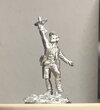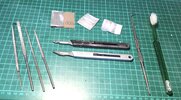Hi all.
Some of you, well, one or two, have asked if I could do another SBS on painting small figures. It’s a couple of years since I did the last one, and some things I do slightly differently than I did then, so here we go…….
The victim is going to be this guy

There have been a few aircraft group builds recently, so he seems appropriate. I’m sure most of us feel like him when we build aircraft models, and I bet more than one of us has done this with a build, including appropriate Dakka Dakka Dakka noises…..
He is a white metal figure that was given away as a freebie to those that went to the Salute 2020 wargames show at Olympia in London. The theme in 2020 was the eightieth anniversary of the Battle of Britain. Unfortunately the show was held back by Covid, so I got him in the eighty one and a half anniversary……
The sculptor was Paul Hicks, well known in wargames figure circles, and he is slightly caricatured rather than being absolutely to scale. Not sure quite how well he will paint up, so let’s see……
Next part will be cleaning up tools…..if you want to know anything, or I haven’t explained anything properly, just give me a shout and I’ll do what I can…..
Some of you, well, one or two, have asked if I could do another SBS on painting small figures. It’s a couple of years since I did the last one, and some things I do slightly differently than I did then, so here we go…….
The victim is going to be this guy

There have been a few aircraft group builds recently, so he seems appropriate. I’m sure most of us feel like him when we build aircraft models, and I bet more than one of us has done this with a build, including appropriate Dakka Dakka Dakka noises…..
He is a white metal figure that was given away as a freebie to those that went to the Salute 2020 wargames show at Olympia in London. The theme in 2020 was the eightieth anniversary of the Battle of Britain. Unfortunately the show was held back by Covid, so I got him in the eighty one and a half anniversary……
The sculptor was Paul Hicks, well known in wargames figure circles, and he is slightly caricatured rather than being absolutely to scale. Not sure quite how well he will paint up, so let’s see……
Next part will be cleaning up tools…..if you want to know anything, or I haven’t explained anything properly, just give me a shout and I’ll do what I can…..



